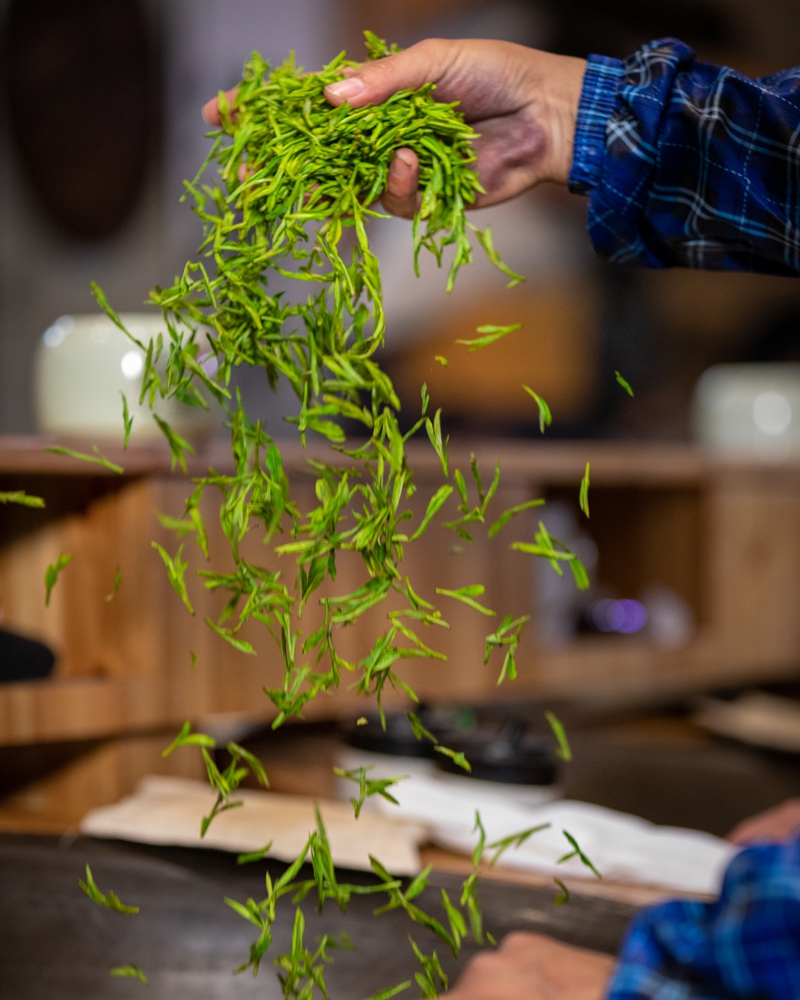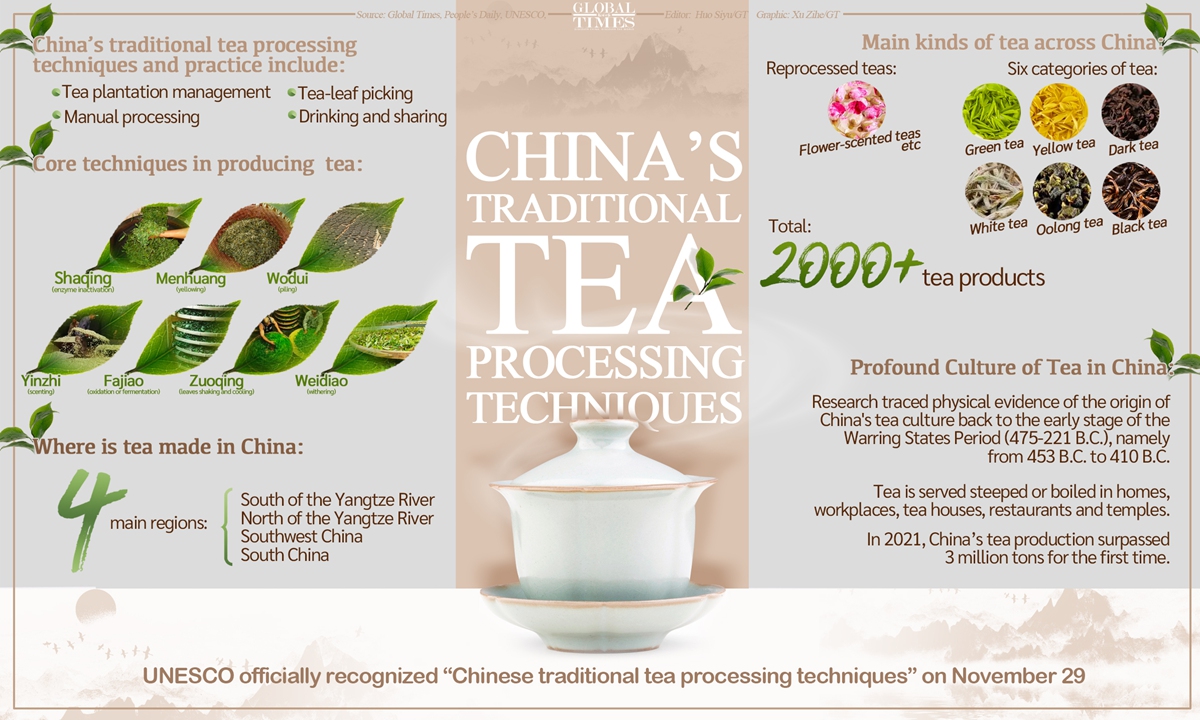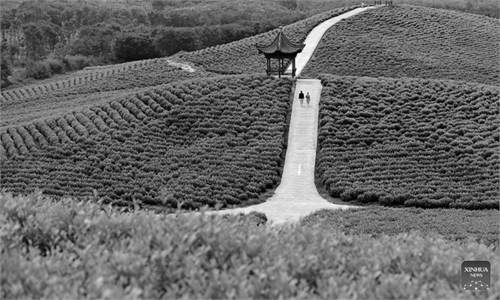ARTS / ART
Ancient tea-making techniques become latest world cultural intangible heritage, highlighting nation’s contribution

A worker tests the dryness of tea leaves. Photo: VCG

China's traditional tea processing techniques.Graphic:Xu Zihe/GT, Editor: Huo Siyu/GT
Editor's Note:
China's traditional tea-making techniques and their associated social practices successfully became UNESCO's latest world intangible cultural heritage on Tuesday, increasing the number of world intangible cultural heritages in China to 43.
Tea is ubiquitous in Chinese people's daily life and has also influenced the lives of people around the world through the Silk Road. It's a pleasure to see the successful application of this ancient art. In this series on Chinese tea culture, the Global Times will share with readers what makes this intangible cultural heritage so special.
This is the first installment, which introduces why the tea culture can be inscribed into the list, and the second installment will elaborate the role that tea has played in international exchanges.
Traditional Chinese tea-making techniques were officially recognized by UNESCO on Tuesday, as the techniques and associated social practices were added to the Representative List of Intangible Cultural Heritage for Humanity that day. With 43 items on the list, China maintains its No.1 position in the field.
The decision was announced at the 17th session of the UNESCO Intergovernmental Committee for the Safeguarding of the Intangible Cultural Heritage held in the Kingdom of Morocco.
With the success of the application started in March 2021, the list of world intangible cultural heritage has recognized the knowledge, skills, and practices concerning management of tea plantations, picking of tea leaves, manual processing, and the drinking and sharing of tea.
The result has been widely hailed by the Chinese public and experts as it is a significant step for conservation and promotion of traditional tea culture.
"Chinese tea culture became widely known by people in many countries around the world years ago through the ancient Silk Road. The successful application of Chinese tea-making can further help improve its international influence," Zheng Changling, secretary general of the China Folk Culture Innovation and Development Center and a research fellow at the Chinese National Academy of Arts, told the Global Times.
Secret in the leaves
Tea is ubiquitous in Chinese people's daily life, as steeped or boiled tea is served at home, workplaces, tea houses, restaurants and temples, to name a few. It is also an important part of social events and ceremonies such as weddings and praying to the ancestors.
Based on natural conditions and local customs, Chinese tea producers have developed six categories of tea - green, yellow, dark, white, oolong and black - and there are other varieties like flower-scented teas and more than 2,000 tea products.
Processing tools include woks, bamboo trays and drying frames, while core steps consist of shaqing (enzyme inactivation), menhuang (yellowing), wodui ( piling), weidiao (withering), zuoqing (leaf shaking and cooling), fajiao (oxidation or fermentation) and yinzhi (scenting). All these teas, with their diverse colors, aromas and flavors, meet the different needs of people.
Because various natural growing conditions are more suitable for certain types of tea, the different categories of tea are distributed into diverse regions around China. The application for the list was jointly submitted by different organizations from these regions, including the Cultural Center of Wuyishan, which is responsible for safeguarding Wuyi Rock Tea (Dahongpao Tea), and the Longjing Tea Industry Association of the Xihu district in Hangzhou, East China's Zhejiang Province, which is responsible for Green Tea (West Lake Longjing Tea).
Wuyi Mountain in Fujian is home to one of the oldest and largest tea gardens in China thanks to the region's excellent natural environment. Provincial intangible inheritor of tea-making technique Zhang Zhifeng from Fujian also established his workshop here, attracting hundreds of students every year.
"Because of changes that occurred over tea's extremely long history, the tea-making process has become very complicated and diverse today," Zhang told the Global Times.
"Yet to comply with the rather strict steps which may include dozens of smaller steps, generally speaking, it takes about half a month to complete the beginning processes such as tea picking, selecting and drying. However, in order to reach the most refined standard, it takes at least a whole month only to dry the tea as dry as it can get. So it takes several months alone before a batch of good tea products is ready for consumers," he said.
"The history of tea-making is too long. However, this listing as a world cultural heritage item is sure to bring new nourishment," Zhang noted.
Value of harmony
Speaking of the reasons why the application succeeded, UNESCO said that China's tea culture has nurtured social practices, traditional skills and handicrafts and reflects Chinese people's values of modesty, harmony and respect.
Zheng believed that it was mainly due to the profound history of Chinese tea culture, which trekked along the ancient Tea Horse Road - a network of caravan routes that can be traced back to the Tang Dynasty (618-907) - to reach as far as West Asia and East Africa.
The inclusion on the UNESCO list is sure to have a significant impact on the further development and preservation of tea culture.
Yu Jinlong, a cultural expert specializing in tea, told the Global Times on Wednesday that the inclusion is valuable because it will encourage people to pursue healthier lifestyles by incorporating tea culture in their daily lives, which is sure to improve their sense of happiness.
"China's traditional tea processing techniques addition to the UNESCO list has further boosted Chinese people's cultural confidence, and it is also a good move for the building of a community with a shared future for mankind," he said.

